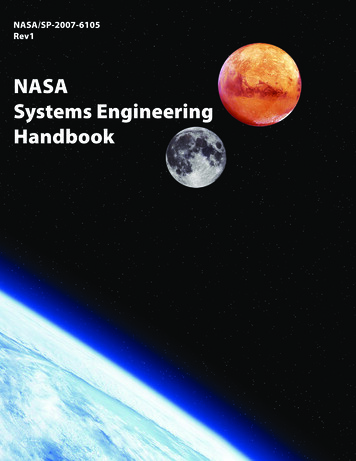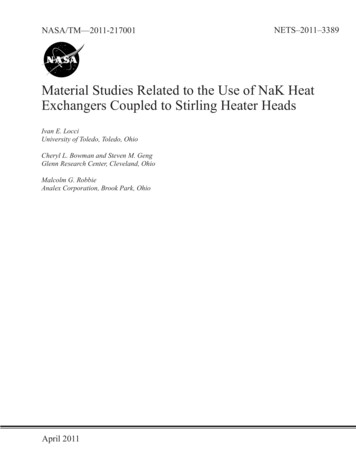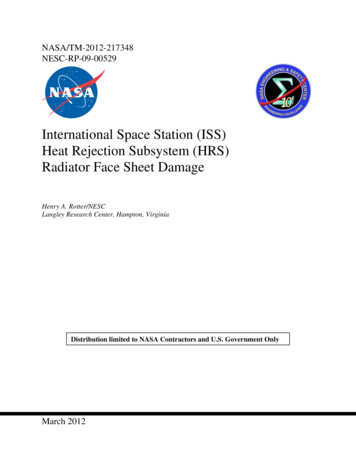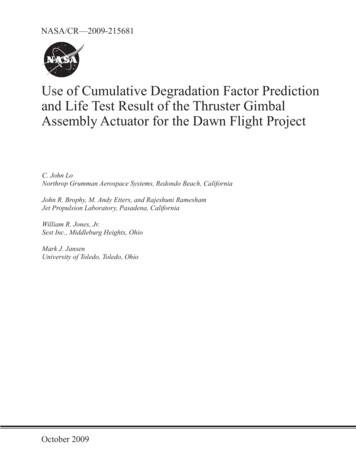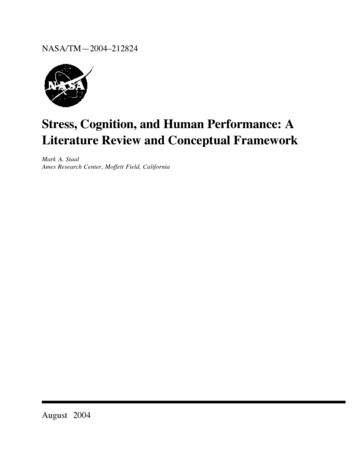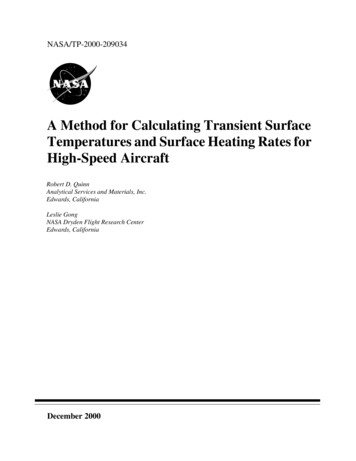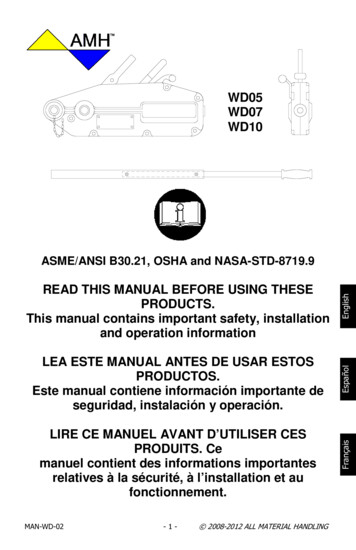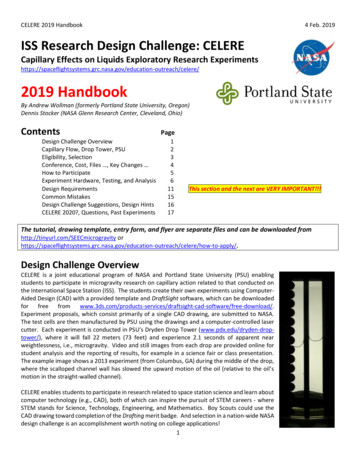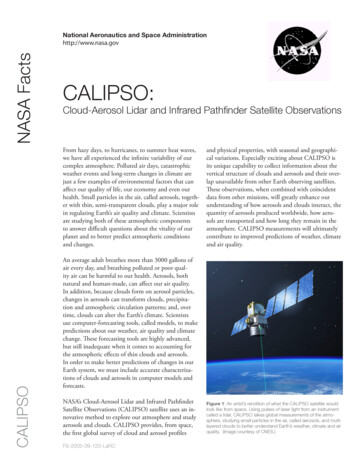
Transcription
NASA FactsNational Aeronautics and Space osol Lidar and Infrared Pathfinder Satellite ObservationsCALIPSOFrom hazy days, to hurricanes, to summer heat waves,we have all experienced the infinite variability of ourcomplex atmosphere. Polluted air days, catastrophicweather events and long-term changes in climate arejust a few examples of environmental factors that canaffect our quality of life, our economy and even ourhealth. Small particles in the air, called aerosols, together with thin, semi-transparent clouds, play a major rolein regulating Earth’s air quality and climate. Scientistsare studying both of these atmospheric componentsto answer difficult questions about the vitality of ourplanet and to better predict atmospheric conditionsand changes.and physical properties, with seasonal and geographical variations. Especially exciting about CALIPSO isits unique capability to collect information about thevertical structure of clouds and aerosols and their overlap unavailable from other Earth observing satellites.These observations, when combined with coincidentdata from other missions, will greatly enhance ourunderstanding of how aerosols and clouds interact, thequantity of aerosols produced worldwide, how aerosols are transported and how long they remain in theatmosphere. CALIPSO measurements will ultimatelycontribute to improved predictions of weather, climateand air quality.An average adult breathes more than 3000 gallons ofair every day, and breathing polluted or poor quality air can be harmful to our health. Aerosols, bothnatural and human-made, can affect our air quality.In addition, because clouds form on aerosol particles,changes in aerosols can transform clouds, precipitation and atmospheric circulation patterns; and, overtime, clouds can alter the Earth’s climate. Scientistsuse computer-forecasting tools, called models, to makepredictions about our weather, air quality and climatechange. These forecasting tools are highly advanced,but still inadequate when it comes to accounting forthe atmospheric effects of thin clouds and aerosols.In order to make better predictions of changes in ourEarth system, we must include accurate characterizations of clouds and aerosols in computer models andforecasts.NASA’s Cloud-Aerosol Lidar and Infrared PathfinderSatellite Observations (CALIPSO) satellite uses an innovative method to explore our atmosphere and studyaerosols and clouds. CALIPSO provides, from space,the first global survey of cloud and aerosol profilesFS-2005-09-120-LaRCFigure 1: An artist’s rendition of what the CALIPSO satellite wouldlook like from space. Using pulses of laser light from an instrumentcalled a lidar, CALIPSO takes global measurements of the atmosphere, studying small particles in the air, called aerosols, and multilayered clouds to better understand Earth’s weather, climate and airquality. (Image courtesy of CNES.)
CALIPSO: Cloud-Aerosol Lidar and Infrared Pathfinder Satellite Observations02How Aerosols and Clouds Affect Climate and Air QualityOur climate is the product of a delicate and complicated balance of energy – a balance between energyreceived from the sun and energy reflected and emitted back to space from Earth. Clouds affect the radiation balance directly by reflecting sunlight into space,which prevents energy from reaching the surface, thuscooling both the ground and the atmosphere. Cloudscan also absorb heat emitted by the Earth, calledthermal radiation. When clouds absorb this thermalradiation, less energy escapes to space and the planetwarms. The degree to which the energy balance tips inone direction – either warming or cooling – is heavilydependent on the altitude, thickness and overlappingstructure of clouds.Low lying clouds, which are often made of waterdroplets, have almost the same temperature as thesurface, so when they absorb thermal energy emittedby the surface they re-emit it at the same temperature.Low lying clouds cause little change on the flow ofthermal energy – their primary role is to reflect solarenergy. High thin clouds, on the other hand, arecolder and capture more heat from the surface andemit less energy to space. They often reflect less solarenergy than the heat they absorb, thus warming theatmosphere. High clouds are colder and are mostlymade of ice. Knowing where clouds are in altitude,as well as their composition (ice or water) will helpscientists to better understand the affects of clouds onchanges in atmospheric circulations and on climate.To further complicate matters, clouds often overlap,making them very difficult to study.Aerosols can also directly affect the radiation balanceand impact climate. Like clouds, aerosols can reflectsunlight back to space and cool the atmosphere. Forexample, the haze layer formed from sulfuric acidindustrial pollution reflects sunlight. Unlike clouds,however, aerosols can absorb sunlight and warm theatmosphere. “Black carbon,” such as soot emitted bydiesel engines, is a type of aerosol that can absorb significant amounts of sunlight, particularly when theselayers lie over a bright surface like a low lying cloud. Itis important that we distinguish among the differenttypes of aerosols and have accurate knowledge of thealtitude of aerosol layers in order to know their effecton Earth’s energy balance. Learn more about aerosolsin “Aerosols: More than Meets the Eye,” a “NASAFacts” publication (NASA GSFC).Figure 2: Multi-layered clouds, like those seen below, are a major source of uncertainty for scientists studying Earth’s radiation balance.CALIPSO’s imaging and lidar system provides new insight into clouds, specifically high thin clouds that are often invisible to radar. (NASAimage courtesy Doug Stoddard and NASA’s Students’ Cloud Observations On-Line [S’COOL] Program.)FS-2005-09-120-LaRC
meter (1 ten-thousandth -of an inch) can work theirway deep into the lungs and aggravate or cause breathing problems. The risk is particularly high for theelderly and the very young. Aerosols can also threatenthe safety of aviation. They reduce visibility overheavily polluted areas, and during volcanic eruptions,planes have to reroute around the eruption to preventparticles from being taken into their jet engines.Why we Need CALIPSO?Aerosols can also change the properties of clouds andindirectly affect our climate. Cloud droplets formaround aerosols such as salt from sea-spray, dustblown from the desert or fine particles from industrial emissions. Changing the characteristics of theseaerosols, such as their number and size, can changethe characteristics of the cloud droplets and, thus,the clouds that they form. As an example, scientistshave observed that clouds below exhaust plumes fromships are brighter. This change in the clouds resultsfrom smaller particles in the exhaust that cause morenumerous, but smaller cloud droplets to form. Withthe smaller cloud droplets, the clouds can also remainintact longer because precipitation in these cloudsis slower to form. Conversely, scientists believe thatunder some circumstances aerosols cause clouds todissipate faster and some aerosols even prevent cloudsfrom forming in the first place. Unfortunately, howaerosols affect clouds remains a mystery, and we don’tknow exactly which of these processes is significantenough to effect our weather, climate and air quality.Aerosols often have some serious impacts on society –posing a threat to public health and even endangeringair traffic. On hot, humid, stagnant summer days, theair quality over urban areas often reaches unhealthylevels and aerosols are a primary culprit. Tiny aerosolparticles with diameters less than 2.5 millionths of aTo improve predictions of climate change, to helpdevise strategies for limiting pollution and to improveforecasts of harmful air quality conditions, we needbetter information on aerosol sources and how aerosols enter the atmosphere and interact with circulation patterns. A key piece of information that is notprovided by currently operating observational satellitesis the altitude of aerosol layers in the atmosphere, adeficiency that is hindering our ability to improveforecasts.03CALIPSO: Cloud-Aerosol Lidar and Infrared Pathfinder Satellite ObservationsFigures 3a and 3b: The amount of aerosol present when a cloudforms impacts the characteristics of the cloud that forms. Figure 3ashows a “non-polluted” case, and Figure 3b showas a “polluted”case. In both cases, the same amount of water vapor is present,but in the “polluted” case, the water molecules are spread outover many more particles and it takes longer for water droplets togrow large enough to fall as precipitation (see insets). (Image creditAlex McClung, SSAI/NASA GSFC, and University Corporation forAtmospheric Research.)Obtaining better information on the height andthickness of clouds is also needed. At present, scientists have considerable difficulty predicting the areacoverage, water and ice content and altitude of clouds.Inaccuracies in these parameters can lead to largeerrors in estimates of precipitation and the effects ofclouds on atmospheric circulation and climate.Having better information on aerosols and cloudswill be used by scientists in computer programs calledclimate models to understand the behavior of andmake predictions about climate. Climate models aremathematical representations of natural processes thatoccur in the atmosphere, in the oceans and on theland. While they are invaluable tools, we need scientific studies to learn how to improve the models so thatthey make better predictions. In these models cloudsand aerosols are often poorly represented. At best, scientists are making only rough estimates of their effectson the atmosphere, rather than using actual data toguide the simulations. Researchers need to learn moreabout how clouds and aerosols help cool and warmthe Earth, how they interact with each other and howFS-2005-09-120-LaRC
CALIPSO: Cloud-Aerosol Lidar and Infrared Pathfinder Satellite Observations04Figure 4: Demostrating that lidar measurements could be taken from space, the LITE mission (Lidar In-space Technology Experiment), conducted in 1994 on the Space Shuttle, was really the proving ground for CALIPSO’s lidar technology. Shown above is a visualization of LITEdata where lidar proflies are combined into slices of the atmosphere. A number of slices from different orbits shown side-by-side reveals the3-D distribution of aerosols and clouds around the globe. In this image, South America is seen in the foreground and North America is in thebackground. In the lidar profiles, high, thin clouds; low layers of aerosols, like dust and biomass burning; and thick, tropical convective cloudsystems can all be seen. (NASA image by Chip Trepte and Kurt Severance.)human activities will change them and their effects onthe climate in the future.How CALIPSO sees the atmosphereScientists have been observing clouds and aerosolsglobally from space for many years using passive imagers – sensors that measure the amount of radiationreflected and emitted by the Earth. These sensors observe how clouds and aerosols vary with latitude andlongitude, but provide, at best, limited information onhow they vary with altitude. CALIPSO combines aninnovative combination of an active lidar (light detection and ranging) instrument with passive infraredand visible imagers to probe the vertical structure andproperties of thin clouds and aerosols over the globe.FS-2005-09-120-LaRCThe lidar is an active remote sensing technique, wherepulses of light are sent from the satellite toward thesurface and the amount of light that is reflected, orscattered back to the spacecraft from thin vertical segments of the atmosphere is measured. It is similar toradar in operation; however, lidar uses short pulses oflaser light instead of radio waves to probe the atmosphere. The lidar data from CALIPSO allows scientiststo identify the composition of clouds, to estimatethe abundance and sizes of aerosols and to determineprecisely the altitudes of clouds and aerosol layers andthe extent of layer overlap.Each lidar measurement is a 100-meter wide snapshot or profile of the atmosphere. The profiles can bestreamed together to paint a picture of what a verticalslice of our atmosphere looks like. If you could envi-
Complementing CALIPSO’s lidar, is a sensor calledthe Imaging Infrared Radiometer, or IIR. The IIRis provided by the French Centre National d’EtudesSpatiales (CNES), NASA’s partner in the CALIPSOmission. This instrument has a swath of 64 kilometers(about 40 miles) across the satellite ground track andmeasures, at three different wavelengths, the outgoing thermal radiation emitted toward space from theatmosphere. Its design allows scientists to estimatethe size of ice cloud crystals and helps to estimate theamount of heat clouds absorb and emit. The lidarmeasurement aids our interpretation of the IIR observations with concurrent measurements of the altitudesof these clouds.A third instrument that CALIPSO carries is a highresolution digital camera. This camera, called thewide-field camera, or WFC, provides a large-scale viewof the atmosphere surrounding the thin column of airprobed by the CALIPSO lidar, providing a contextfor interpreting the observations. From these images,scientists will be able to tell whether a cloud featureseen by the lidar is a small, isolated cloud or one thatis part of a larger field of clouds. Together, the innovative combination of the lidar, the IIR and the WFCwill strengthen our understanding of cloud propertieslike never before.The Future of CALIPSOWith an expected three year lifetime, CALIPSO isdesigned to fly in formation with four other satellites, called the “Afternoon-Train” or the “A-Train”satellite constellation, that collect a wide variety ofcoincident measurements. The five members of theA-Train include, Aqua, Aura, CALIPSO, CloudSat,and PARASOL (Polarization and Anisotropy ofReflectances for Atmospheric Sciences coupled withObservations from a Lidar). A sixth mission, OrbitingCarbon Observatory (OCO) will eventually join theconstellation.Each satellite in the A-Train formation measures theatmosphere somewhat differently and, thus offersunique and complimentary information on cloudsand aerosols. CALIPSO provides profile observationsof aerosols and thin clouds. Aqua, the lead spacecraft,provides additional observations of clouds and aerosolsusing passive sensors with greater horizontal coverage,but very limited altitude information. It also providesvaluable information on environmental conditionsneeded to understand how aerosols and clouds formand change. CloudSat, CALIPSO’s launch partner,uses a revolutionary radar to probe the internal structure of clouds. PARASOL uses polarized light measurements to help distinguish between different typesof natural and human-produced aerosols. And finally,Aura studies key atmospheric pollutants that can helpshow the sources of aerosols and how they are transported. Combining the A-Train observations providesan unprecedented opportunity to better understandour delicate Earth system than could be gained from asingle satellite alone.The near-simultaneous A-Train observations areachieved through high-precision satellite formation flying. The leading (Aqua) and trailing (Aura)spacecraft in the formation are maintained in orbitwithin 15 minutes of each other, while traveling atover 15,000 miles per hour. CloudSat and CALIPSOare controlled to an even finer requirement, within15 seconds of each other, so that both instrumentsuites can view the same cloud area at nearly the samemoment. Because CloudSat and CALIPSO are soclosely aligned, and because they take complementarymeasurements, their measurements can be combinedvirtually seamlessly. CALIPSO is sensitive to semitransparent clouds and aerosols not seen by CloudSat’sradar, while the radar is able to penetrate dense cloudswhich block the lidar pulse.05CALIPSO: Cloud-Aerosol Lidar and Infrared Pathfinder Satellite Observationssion the observations from other satellites appear likeX-ray images of the human body, then lidar wouldprovide a view like a CAT scan – an advanced 3-Dimaging technique that shows the spatial relations between different objects as well as their relative depth.With an X-ray, you can see inside the human body,but you can’t tell how things are layered. The CATscan, and thus the lidar, is a breakthrough because itallows us to see the layers beneath other layers. TheCAT scan sees layers of human organs and tissues,while the lidar sees layers of aerosols and clouds. Lidarmeasurements are also unique because the slices of theatmosphere taken from multiple orbits can be combined to create a 3-D view of aerosols and clouds overthe entire globe.Upon successful completion of the CALIPSO mission,the collected data will allow scientists to better understand aerosols and clouds and, ultimately, improveforecasts of air quality and climate. CALIPSO observations will improve global estimates of how aerosolsaffect the Earth’s radiation balance. Using CALIPSO’sdata, scientists will have new ways to determine howthe climate, aerosols and clouds interact.FS-2005-09-120-LaRC
CALIPSO: Cloud-Aerosol Lidar and Infrared Pathfinder Satellite Observations06Figure 6: CALIPSO is part of a constellation of satellites called the A-Train: Aura, PARASOL, CALIPSO, CloudSat, Aqua and eventually,OCO. The concept behind the A-Train comes from the idea that no single tool can do everything. To build a house, for instance, carpenters, plumbers, roofers, electricians and others apply unique skills and tools to discreet tasks, while collectively focusing on a larger job athand. Similar to building a house, the string of A-Train satellites flying in a precise formation allows discreet instruments to bring their uniqueobseravation abilities to bear on essentially the same place on Earth at the same time. (Image courtesy of Alex McClung, SSAI/GSFC; somecaption text courtesy of Michael Starobin, GSFC.)CALIPSO Team MembersCALIPSO is a joint partnership between the UnitedStates (NASA) and France (CNES). Other teammembers include Ball Aerospace & TechnologiesCorp., Hampton University and Institut Pierre SimonLaplace.SummaryCALIPSO will provide us global 3-D perspectives onEarth’s aerosols and clouds that will answer questionsabout how they form, evolve and affect our weather,climate and air quality. CALIPSO employs innovative measurement technologies that will probe Earth’satmosphere as never before. In partnership with thesatellites in the A-Train, CALIPSO fuels discoveriesthat will improve our air quality and climate forecasts,while helping public policy makers and business leaders make more informed, long-term environmentaldecisions about public health and the economy.The Earth-Sun System Division of NASA’s ScienceMission Directorate is dedicated to connecting theseEarth observations to practical applications in societyFS-2005-09-120-LaRCso that its science results serve society and the maximum number of people possible benefit from NASAresearch. This dedication is a manifestation of NASA’svision to improve life here and its mission to understand and protect our home planet.For more information on CALIPSO, visit:http://www.nasa.gov/calipso
air traffic. On hot, humid, stagnant summer days, the air quality over urban areas often reaches unhealthy levels and aerosols are a primary culprit. Tiny aerosol particles with diameters less than 2.5 millionths of a meter (1 ten-thousandth -of an inch) can work their way deep into

